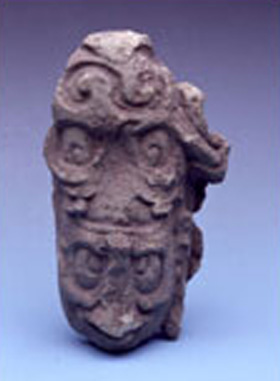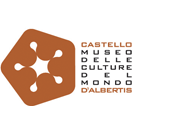
Click here to view image
Sculpted volcanic tuff
Representation of Chac, the Mayan god of storms and the rain, with his characteristic rounded, wide-open eyes. The piece was part of the summit of stele A, from which two similar fragments believed to represent the same deity were missing in symmetrical positions. As stele A is one of the few to have neither fallen nor collapsed, the manner of its removal remains unclear. The item was brought to Genoa for the 1892 exposition organised by the US Catholic Mission Association in honour of Cristopher Columbus. It is interesting to note that a depiction of the figure in Alfred Maudslay's Central-American Biology, dated 1889-1902, shows it in its original position at the foot of the stele, still intact and undamaged. The stele itself, like numerous sculptures, temples, and altars within the city, is a monument to the endeavours of the 13th Mayan lord of Copán, 18 Rabbit or XVIII Jog, who reigned from 695 to 738 AD. Today, exact copies of this original fragment have been taken to the archeological site in Copàn, where a reproduction has been placed in its original position in order to reconstitute the stele. Only precise copies produced in the years following the first archaeological digs conducted by Harvard University in 1895, remain on the original site. Further copies of this particular fragment are displayed in the neighbouring museum, where all the other recovered originals are housed and displayed.




